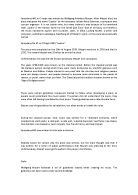Musical tension is created as Beethoven slowly builds up the anticipation with several crescendos and sforzandi used to emphasize transitions to new chords, and new chords themselves- which are played on the first beat of bars 13 (C), 19 (Dm), 25 (G7)- respectively. This G7b dominant chord is then emphasized on the first beat of bars 27 and 29 as it moves from G7c to G7d.
Here the 3 note melodic motif (which moves upwards from the fifth to the major seventh to the tonic note) is a key element of the first subject from bars 13 to 31. The motif is played after each new transition and starts immediately from bar 13. It is played twice, followed by being played in staccato twice (playing the tonic note once more after the motif is played) and then it is used to lead into a staccato 5-note arpeggio-which includes the leading note- of the chord (C and then Dm). The motif is then played in staccato through the G7 inversions. It is important to note that here the notes are different relative to the chord changes; first the motif emphasizes 1,3 and 5 (in G7b and G7c). Then it changes to 3,5 and 7 (G7d). This 3,5,7 motif is then played an octave higher before leading into a descending arpeggio of G7 which leads into C major.
There is also a small 4-note semiquaver-descending (from the fifth down the scale) motif played before bars thirteen and nineteen to lead into the tonic note after which the main motif is played.
Following the exposition of the first subject, Beethoven begins the bridge passage (which lasts from bar 33-52) firmly in the key of C major after going through the 1-2-5 chord progression played previously.
A feature that is repeated from the first subject is the descending semiquaver motif (violins bar 34, woodwind bar 36). This use of the repeated motif showcases the imitation occurring between the strings and the woodwind between bars 33-41. The texture here is much thicker as both the string and woodwind sections play together simultaneously throughout the bridge. The dynamics are also much louder (fortissimo).
Beethoven continues to build tension before moving into the second subject by the use of sforzandi between bars 34-40 and a long crescendo during the transition from C to G in bars to 41 45. After the transition, the key of G major is emphasized by the tonic pedal used in the timpani and trombone between the transition and the beginning of the second subject (bars 45-52)- with the exception of bars 49-50, in which they play both G and C. The woodwind interject with melodic phrases as the strings emphasize a repeated plagal cadence from G-C-G.
The second subject is now firmly set in the key of G major (the dominant of the main key, C). Beethoven immediately makes it clear that the second subject has begun by suddenly changing the dynamics (piano) and the woodwind plays the main melody- for the first time- in a flute/oboe dialogue between bars 52-56, followed by a transition in bars 57-60 (a clear homophonic texture punctuated by strings accentuating off beats in bars 57-60) to the strings playing a repeat of the melody and again the transition in bars 60-68, which ends on an imperfect D7 cadence.
This is then resolved in bar 69 with a G major chord. Between bars 69 and 77 there is a very high energy passage, played at a forte volume; there are several sforzandi between bars 71-74. The addition of brass adds to a suddenly thicker texture. The strings play a repeated fast motif consisting of four semiquavers (tremolo) followed by a staccato crotchet, and this is linked to the next repeat of the motif by a rising quaver figure. Between bars 73-77 there is a line based on the opening of the second subject (bar 53) combined with scalic passages before ending with a crescendo in bar 75 to a fortissimo Ib-IV-Ic-V7 chord progression ending with the tonic chord (perfect cadence) in bar 76.
Subsequently, there is a sudden clear change to the tonic minor (G minor) in bar 77. The dynamics are pianissimo. The plaintive oboe melody begins in bar 79 and ends in bar 84. There is a large registral difference between the oboe line and the rest of the instruments. The strings outline the chords on every crotchet beat as the bass line moves from each tonic note to the next in a scalic manner. The harmony here moves rapidly through the circle of fifths, passing through C minor, Bb major and back to G minor in bar 83.
From bars 85-87, there is a crescendo from piano to forte as the harmony moves through an interrupted cadence and a II7b-V7 in bar 87 to G major (I) in bar 88. Here begins the fourth and final main section of the second subject, although it could be considered to be part of the codetta. It is firmly in G major throughout and is a culmination of all the musical elements- such as the original three-note motif from the first subject- that have occurred before. It is perhaps the most energetic section of the movement so far, and Beethoven once again employs the use of fortissimo dynamics and several sforzandi as well as the fast tremolo semiquaver-crotchet motif that appeared previously.
The codetta has definitely begun by bar 100, in which the note G is played on the first beat of the bar to signal the end of the previous section with a forte-piano marking. Beethoven introduces a closing tune in the 1st violin part, accompanied by a tonic (G) pedal and punctuated by perfect cadences. He uses several sforzandi once more and affirms a G7 chord with a fortissimo dynamic (in bar 106) in preparation for the return to the exposition. This is followed by a descending, quietening woodwind part outlining the G7 chord in minims.








